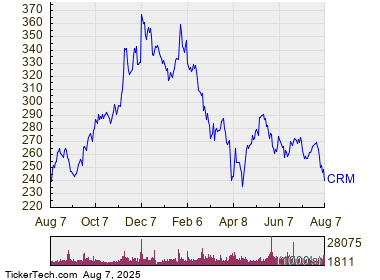Understanding Stock Momentum: An Overview of Salesforce’s RSI
In the world of investing, understanding market sentiment is paramount. Renowned investor Warren Buffett famously stated that one should be cautious when others exhibit greed and should be bold when others show fear. One way to gauge this fear in the stock market is through the Relative Strength Index, commonly referred to as RSI. This technical analysis tool assesses momentum, offering insights into whether a stock might be overbought or oversold.
What is the Relative Strength Index (RSI)?
The Relative Strength Index is a powerful indicator that evaluates price momentum on a scale from 0 to 100. Typically, a stock is deemed oversold when its RSI falls below 30. Such conditions might signal that it has been excessively sold off, possibly presenting a buying opportunity for investors.
Current Status of Salesforce Inc. (CRM)
Salesforce Inc. (Ticker: CRM) recently experienced a significant movement in market sentiment. On Thursday, its shares entered into the oversold category, recording an RSI of 28.9 after trading as low as $236.97 per share. This marked a critical point for potential investors to consider entering the market.
Comparative Analysis with the S&P 500 ETF
To put Salesforce’s performance into context, it’s worth comparing its RSI with that of the S&P 500 ETF (SPY), which currently has an RSI of 59.1. This stark difference suggests that, while the broader market may be experiencing stable or rising conditions, Salesforce is seeing heavy selling pressure, indicating that sentiment around this particular stock might be leveling off.
Investing Insights
For bullish investors, the RSI of 28.9 could indicate that the selling pressure on CRM shares is beginning to wane. This scenario often presents a suitable entry point for those looking to invest. Investors might now assess potential buy opportunities in the stock market, especially with the current levels indicating a potential reversal in price momentum.
Salesforce’s Stock Performance Overview
Looking beyond just the RSI, examining Salesforce’s stock performance over the past year provides further insights. The stock’s 52-week low stands at $230 per share, while its high reaches an impressive $369 per share. With the recent price adjustment, the last trade was at $240.88, suggesting it is currently situated well above its yearly low.
Such statistical data underscores the volatility in Salesforce’s stock, giving traders a clearer picture of its positioning within the market.
Conclusion
In analyzing Salesforce’s RSI and stock performance, uncovering such details helps investors navigate their strategies better in a fluctuating market. With tools like the RSI guiding them, traders can effectively position themselves to capitalize on emerging opportunities in the stock market.
